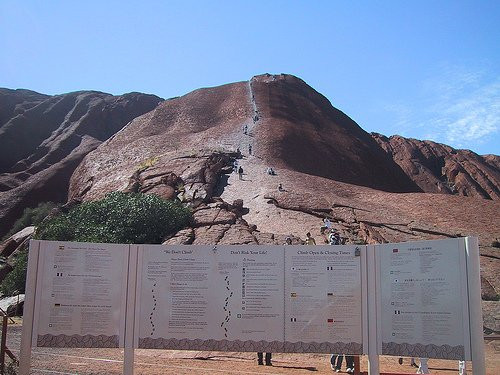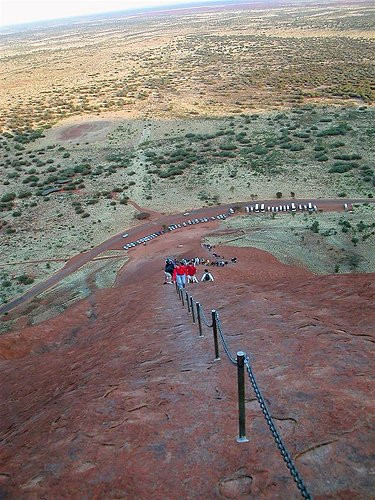How Long Does It Take To Climb Ayers Rock, or Uluru? At rockscapes.net, we understand the allure of this iconic landmark. While the climb is now permanently closed, understanding its history and the cultural significance of Uluru is still essential for any visitor or landscape enthusiast. Let’s explore the story of Uluru and its enduring beauty within the Australian landscape.
1. Understanding Uluru: Facts and Figures
Uluru, also known as Ayers Rock, is a massive sandstone monolith in the heart of Australia. Before its closure to climbers, understanding the physical demands of the ascent was important.
1.1. How High Is Uluru?
Uluru stands 348 meters (1,142 feet) high, comparable to a 95-story building. This impressive height contributed to the challenge and time required for the climb.
1.2. How Long Was the Climbing Path?
The designated climbing path stretched approximately 1.6 kilometers (1 mile) in length. This distance, combined with the steep incline, made for a strenuous hike.
1.3. How Long Did It Take to Climb Uluru?
- For the Fit: A reasonably fit person could ascend Uluru in about 30 minutes, spend another 30 minutes exploring the summit, and then descend.
- For the Average Climber: Most people took around two hours to complete the round trip, including time to rest and take in the views.
- Factors Affecting Climb Time: Weather conditions, such as high winds or extreme temperatures, often led to the closure of the climb. Fitness level also played a significant role.
2. The Closure of the Uluru Climb: A Historical Decision
The decision to ban climbing Uluru was a significant step towards respecting Aboriginal culture and preserving the site’s natural integrity.
2.1. When Did the Uluru Climb Close?
The climb officially closed on October 26, 2019, coinciding with the 34th anniversary of Uluru’s return to its traditional owners.
2.2. Why Was the Climb Banned?
- Cultural Significance: Uluru is a sacred site to the Anangu people, the traditional owners. The climbing route followed a path of spiritual importance reserved for specific Aboriginal men during ceremonies.
- Safety Concerns: Numerous injuries and fatalities occurred over the years due to the climb, causing distress to the Anangu people, who felt responsible for these accidents.
2.3. What Were the Criteria for Closing the Climb?
The Uluru-Kata Tjuta National Park Management Plan outlined specific conditions for closure:
- Successful establishment of alternative visitor experiences.
- A decrease in the proportion of visitors climbing to below 20%.
- Recognition of the cultural and natural significance of Uluru as the primary reason for visiting.
By 2013, the number of visitors climbing had already fallen below 20%, and surveys indicated that the vast majority of people would still visit Uluru even if the climb was closed.
3. Understanding the Cultural Significance of Uluru
Uluru is more than just a rock; it’s a living cultural landscape with deep spiritual meaning.
3.1. Uluru as a Sacred Site
The Anangu people have inhabited the area around Uluru for tens of thousands of years. The rock is central to their creation stories, known as Tjukurpa.
3.2. Tjukurpa: The Foundation of Anangu Culture
Tjukurpa encompasses the laws, stories, and ceremonies that govern Anangu life. Uluru is a physical manifestation of these stories, with its features representing ancestral beings and events.
3.3. Respecting Anangu Wishes
The Anangu people have long requested that visitors refrain from climbing Uluru out of respect for their culture and traditions.
 Sign requesting visitors not to climb Uluru
Sign requesting visitors not to climb Uluru
4. Alternative Ways to Experience Uluru
Even without the climb, there are many enriching ways to connect with Uluru and its surroundings.
4.1. Guided Walks and Tours
Anangu guides offer interpretive walks that share the stories and significance of Uluru, providing insights into Aboriginal culture and the natural environment.
4.2. Cultural Centre Visits
The Uluru-Kata Tjuta Cultural Centre provides in-depth information about Anangu culture, art, and history. Visitors can participate in workshops, view traditional crafts, and learn about the Tjukurpa.
4.3. Scenic Flights
Helicopter and fixed-wing flights offer breathtaking aerial views of Uluru and the surrounding landscape, including Kata Tjuta (the Olgas).
4.4. Sunset and Sunrise Viewings
Witnessing the changing colors of Uluru at sunrise and sunset is a mesmerizing experience. Viewing platforms provide optimal vantage points.
4.5. Stargazing
The remote location of Uluru offers unparalleled opportunities for stargazing. Guided tours highlight constellations and Aboriginal astronomy.
5. The Controversy Surrounding the Climb
Before the ban, climbing Uluru was a subject of intense debate.
5.1. Conflicting Views
Many tourists were unaware of the cultural significance of Uluru and the Anangu people’s wishes. Some felt entitled to climb after paying the park entry fee.
5.2. Ethical Considerations
The debate raised questions about cultural sensitivity, respect for indigenous rights, and the impact of tourism on sacred sites.
5.3. The Tourism Industry’s Role
The tourism industry initially promoted the climb, contributing to the perception that it was a must-do activity. However, attitudes gradually shifted as awareness of the cultural issues increased.
6. Exploring the Geology of Uluru
Understanding the geological formation of Uluru adds another layer to its appreciation.
6.1. Formation of Uluru
Uluru is composed of arkose, a type of sandstone rich in feldspar. It was formed over millions of years from sediments deposited in an ancient sea.
6.2. Unique Geological Features
The rock’s distinctive shape and features are the result of weathering and erosion. The vertical striations are caused by water runoff.
6.3. The Significance of Kata Tjuta
Located nearby, Kata Tjuta (the Olgas) is another group of impressive rock formations. Together, Uluru and Kata Tjuta create a stunning landscape.
7. Planning Your Visit to Uluru
While climbing is no longer an option, a trip to Uluru remains a rewarding experience.
7.1. Best Time to Visit
The cooler months (May to September) are generally the most comfortable for visiting Uluru. Temperatures can be extreme during the summer.
7.2. Accommodation Options
Ayers Rock Resort offers a range of accommodation options, from camping to luxury hotels.
7.3. Park Entry Fees
A park entry fee is required to access Uluru-Kata Tjuta National Park. Fees contribute to the upkeep of the park and its facilities.
7.4. Respecting the Environment
Visitors are encouraged to minimize their impact on the environment by staying on marked paths, disposing of waste properly, and conserving water.
8. Uluru and Landscape Design: Inspiration from the Outback
Uluru’s striking form and the surrounding desert landscape can inspire unique landscape designs.
8.1. Incorporating Native Plants
Using native Australian plants in your landscape design can create a connection to the Outback. Consider species that thrive in arid conditions.
8.2. Using Natural Stone
Natural stone can be used to create rock gardens, pathways, and other features that evoke the rugged beauty of the Australian desert.
8.3. Xeriscaping Techniques
Xeriscaping is a water-wise landscaping approach that is well-suited to dry climates. It involves using drought-tolerant plants and minimizing water usage.
8.4. Creating Focal Points
Just as Uluru dominates the landscape, a focal point can add visual interest to your garden. This could be a large rock, a sculpture, or a water feature.
9. The Enduring Appeal of Uluru
Even without the climb, Uluru continues to captivate visitors with its natural beauty, cultural significance, and spiritual power.
9.1. A Symbol of Australia
Uluru is one of Australia’s most recognizable landmarks, representing the country’s vastness, ancient history, and unique natural environment.
9.2. A Place for Reflection
The remote location and serene atmosphere of Uluru make it a place for contemplation and connection with nature.
9.3. Supporting Indigenous Communities
By visiting Uluru and engaging with Anangu culture, visitors can support indigenous communities and contribute to the preservation of their traditions.
 View of Uluru from a distance
View of Uluru from a distance
10. How Rockscapes.net Can Help You Bring the Beauty of Natural Stone to Your Landscape
At rockscapes.net, we are passionate about the beauty and versatility of natural stone. We offer a wide range of resources to help you incorporate stone into your landscape design.
10.1. Inspiration and Ideas
Browse our gallery of stunning landscape designs featuring natural stone. Get inspired by the possibilities and discover how stone can transform your outdoor space.
10.2. Expert Advice
Our team of experienced landscape designers can provide expert advice on selecting the right stone for your project and creating a design that meets your needs and preferences.
10.3. Quality Materials
We source high-quality natural stone from trusted suppliers. Our selection includes a variety of colors, textures, and sizes to suit any style.
10.4. Installation Guidance
We offer step-by-step guides and tutorials on how to install natural stone features in your landscape. Whether you’re building a rock garden or a stone pathway, we can help you get the job done right.
10.5. Maintenance Tips
Learn how to care for your natural stone features and keep them looking their best for years to come. We provide tips on cleaning, sealing, and protecting your stone from the elements.
11. Essential Considerations for Using Stone in Your Landscape
Choosing the right stone for your landscape involves several important factors.
11.1. Climate and Weather Conditions
Consider the climate in your area and choose stone that is durable and weather-resistant. Some types of stone are more susceptible to damage from freezing and thawing.
11.2. Style and Aesthetics
Select stone that complements the style of your home and garden. Think about the color, texture, and shape of the stone and how it will fit in with your overall design.
11.3. Budget
Natural stone can range in price depending on the type, size, and availability. Set a budget and choose stone that fits within your financial constraints.
11.4. Availability
Some types of stone may be more readily available in your area than others. Check with local suppliers to see what options are available.
11.5. Environmental Impact
Consider the environmental impact of quarrying and transporting stone. Choose stone from sustainable sources whenever possible.
12. Safety Precautions for Working with Stone
Working with stone can be challenging, so it’s important to take safety precautions.
12.1. Wear Protective Gear
Always wear safety glasses, gloves, and sturdy footwear when handling stone.
12.2. Lift Properly
Lift heavy stones with your legs, not your back. Use a hand truck or dolly to move large stones.
12.3. Use Proper Tools
Use the right tools for cutting and shaping stone. Follow the manufacturer’s instructions carefully.
12.4. Work in a Safe Area
Work in a well-ventilated area and keep children and pets away from the work zone.
12.5. Know Your Limits
Don’t attempt to lift or move stones that are too heavy for you. Get help from a friend or hire a professional.
13. Contact Rockscapes.net for All Your Landscape Stone Needs
Ready to bring the beauty of natural stone to your landscape? Contact rockscapes.net today!
13.1. Address
1151 S Forest Ave, Tempe, AZ 85281, United States
13.2. Phone
+1 (480) 965-9011
13.3. Website
rockscapes.net
14. Frequently Asked Questions (FAQs) About Uluru and Landscape Stone
Here are some frequently asked questions about Uluru and using stone in your landscape.
14.1. Is Climbing Uluru Still Allowed?
No, climbing Uluru has been permanently banned since October 26, 2019.
14.2. What Are Some Alternative Activities at Uluru?
Guided walks, cultural center visits, scenic flights, and sunset viewings are all great alternatives.
14.3. What Is the Cultural Significance of Uluru?
Uluru is a sacred site to the Anangu people and plays a central role in their creation stories and traditions.
14.4. What Types of Stone Are Best for Landscaping in Arid Climates?
Drought-tolerant and weather-resistant stones like granite and slate are good choices.
14.5. How Can I Incorporate Natural Stone into My Landscape Design?
Create rock gardens, pathways, retaining walls, or water features using natural stone.
14.6. What Is Xeriscaping?
Xeriscaping is a water-wise landscaping approach that uses drought-tolerant plants and minimizes water usage.
14.7. Where Can I Find Quality Landscape Stone?
Rockscapes.net offers a wide selection of high-quality natural stone from trusted suppliers.
14.8. How Do I Choose the Right Stone for My Project?
Consider the climate, style, budget, and availability when selecting stone.
14.9. What Safety Precautions Should I Take When Working with Stone?
Wear protective gear, lift properly, use proper tools, and work in a safe area.
14.10. How Can Rockscapes.net Help Me with My Landscape Stone Project?
We offer inspiration, expert advice, quality materials, installation guidance, and maintenance tips.
15. Embrace the Beauty of Stone with Rockscapes.net
Uluru’s majestic presence reminds us of the enduring power and beauty of natural stone. Whether you’re planning a trip to the Australian Outback or designing a landscape closer to home, let rockscapes.net be your guide to exploring the possibilities of stone.
Remember, while the climb is no longer possible, the spirit of Uluru lives on. Its cultural significance and natural wonder continue to inspire and captivate all who visit. Discover more about landscape design and natural stone at rockscapes.net today!
16. Uluru’s Impact on Eco-Tourism
The closure of the Uluru climb has significantly boosted eco-tourism in the region.
16.1. Sustainable Tourism
Eco-tourism focuses on minimizing environmental impact and supporting local communities. The ban has encouraged more sustainable tourism practices around Uluru.
16.2. Cultural Sensitivity Training
Many tour operators now offer cultural sensitivity training to ensure visitors understand and respect Anangu traditions.
16.3. Economic Benefits for Local Communities
Eco-tourism initiatives provide economic opportunities for local communities through guided tours, cultural experiences, and the sale of traditional crafts.
16.4. Preservation of Natural Resources
Eco-tourism helps preserve the natural resources around Uluru, ensuring that the site remains pristine for future generations.
17. The Importance of Ethical Travel
The Uluru story highlights the importance of ethical travel and responsible tourism.
17.1. Respecting Local Cultures
Ethical travel involves respecting the cultures and traditions of the places you visit.
17.2. Minimizing Environmental Impact
Reducing your environmental footprint is a key aspect of ethical travel.
17.3. Supporting Local Economies
Supporting local businesses and communities is another important principle of ethical travel.
17.4. Educating Yourself
Educating yourself about the history, culture, and environment of a place can enhance your travel experience and make you a more responsible traveler.
18. Uluru as a Model for Other Sacred Sites
The Uluru experience serves as a model for other sacred sites around the world.
18.1. Protecting Indigenous Heritage
Many indigenous communities are working to protect their sacred sites from tourism and development.
18.2. Balancing Tourism and Preservation
Finding a balance between tourism and preservation is essential for protecting these sites.
18.3. Promoting Cultural Understanding
Promoting cultural understanding and respect can help ensure that sacred sites are visited responsibly.
18.4. Sustainable Management Practices
Implementing sustainable management practices is crucial for preserving the integrity of sacred sites.
19. The Future of Uluru Tourism
The future of Uluru tourism is focused on sustainable and culturally sensitive experiences.
19.1. Digital Tourism
Digital tourism allows people to experience Uluru virtually, reducing the need for physical travel.
19.2. Enhanced Cultural Experiences
Enhanced cultural experiences provide deeper insights into Anangu traditions and history.
19.3. Educational Programs
Educational programs help visitors understand the importance of preserving Uluru for future generations.
19.4. Collaboration with Indigenous Communities
Collaboration with indigenous communities is essential for ensuring that tourism benefits local people and protects cultural heritage.
20. Transform Your Landscape with Rockscapes.net
Uluru stands as a testament to the beauty and significance of natural landscapes. At rockscapes.net, we’re dedicated to helping you bring that same sense of wonder to your own outdoor spaces. Whether you’re inspired by the red desert or prefer a different aesthetic, we provide the resources and expertise to create the perfect landscape.
Visit rockscapes.net today to explore our range of natural stones and discover how you can transform your yard into a stunning retreat. Let us help you create a space that reflects your style and honors the beauty of the natural world, just like Uluru.
21. Latest Trends in Landscape Design with Natural Stone in the US
Stay updated with the latest trends in landscape design that incorporate natural stone, particularly in regions like Arizona.
21.1. Native Stone Integration
Using locally sourced stones like Arizona flagstone to blend landscapes with the surrounding environment.
21.2. Water-Efficient Rock Gardens
Creating drought-resistant gardens using gravel, boulders, and native succulents to conserve water.
21.3. Stone Pathways and Patios
Designing durable and aesthetically pleasing pathways and patios with pavers and natural stone slabs.
| Trend | Description | Stone Types | Benefits |
|---|---|---|---|
| Native Stone Integration | Blending landscapes with local environments using indigenous stone types. | Arizona flagstone, river rocks, local granite | Enhanced aesthetic appeal, reduced environmental impact, supports local economies. |
| Water-Efficient Gardens | Conserving water by using drought-resistant plants and stone mulch. | Gravel, pebbles, boulders, native succulents | Lower water bills, sustainable landscaping, low maintenance. |
| Stone Pathways/Patios | Creating durable and visually appealing outdoor spaces with natural stone. | Pavers, flagstone, cobblestone, slate | Long-lasting, weather-resistant, adds value to property, enhances outdoor living spaces. |
| Vertical Stone Elements | Building retaining walls and garden features with stone veneer. | Stacked stone, manufactured stone veneer, natural stone cladding | Adds texture and dimension, improves drainage, prevents erosion. |
| Fire Pits and Features | Incorporating stone fire pits and outdoor fireplaces for gathering. | Fieldstone, river rock, lava rock | Creates cozy outdoor spaces, extends outdoor season, adds focal point. |
This table summarizes current trends in landscape design using natural stone in the US, focusing on integration, water efficiency, structural and decorative elements, and fire features, highlighting their benefits and stone types.
By incorporating these modern trends and utilizing the information and resources available at rockscapes.net, homeowners and professionals alike can create stunning and sustainable landscapes that celebrate the natural beauty of stone.

